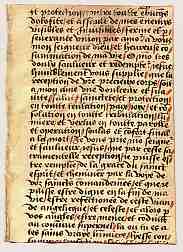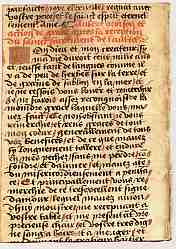

This shows the recto and verso of a leaf from a book of hours of the late 15th or early 16th century, supposedly around 1500, which may be right give or take a bit. It is in the French vernacular, and the language and spelling is much closer to the modern French we all know than that of the 14th century examples shown in these exercises, although apostrophes and accents are still lacking. Some complete books of hours were produced in the French language; in other cases the liturgical texts such as the Hours of the Virgin were produced in Latin, and certain prayers added in the vernacular. I don't know which this represents, as I have only seen a few pages. The text represents parts of two prayers to be said in association with the taking of the sacrament at mass. The desire of the late medieval laity to participate directly in their own private rituals has extended even to that which must be performed by a priest.
The script is a Gothic cursive book hand, very clear and angular but a trifle untidy. It has the tall curved and tapering s formed from two penstrokes, albeit somewhat untidily, such as one finds in more formal bâtarde scripts; very French. It would seem to represent a modest example of the book of hours for the more ordinary class of reader.
The book has clearly seen life, with the vellum rather discoloured. It has presumably been rebound at some time, and in the process the page has been savagely recut, not only reducing the margins but actually cutting clean through the bottom line of each page. Such is the history of working books.
My translation is exceedingly approximate, and is just to give you the idea of what it's all about. As it is only a fragment, with a bit missing in the middle, it is a bit difficult to work out the exact context of some of it. There is enough to get the hang of reading the script, and to follow the general sentiment.
| overview | text | alphabet | abbreviations | exercises | transcript | translation |
If you are looking at this page without frames, there is more information about medieval writing to be found by going to the home page (framed) or the site map (no frames).